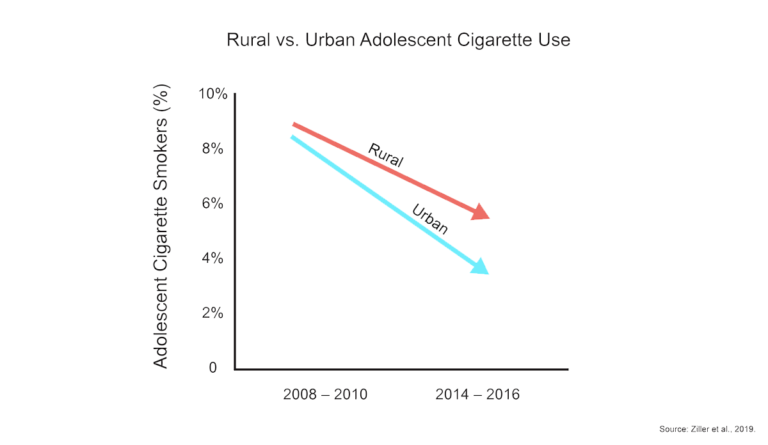Smoking Sticks in the Sticks
Rural youth have 50 percent higher odds of smoking than their urban peers. Without intervention, rural adolescents will bear more of smoking's consequences.

Read Time: 2 minutes
Published:
With the rise of vapes and e-cigarettes, cigarette smoking among youth seems like an artifact of a bygone era. When researchers first collected national data on teenage smokers in 1975, 37 percent reported smoking in the last 30 days. In the past 50 years, cigarette smoking among teenagers decreased by over 600 percent. Cigarettes have become much more expensive during this timeframe, and many teens can’t afford to smoke. Even so, 300,000 youth in the US still light up. Ninety percent of adult smokers began smoking before the age of 18, so teenagers are an important target for tobacco-related interventions.
Erika Ziller and colleagues looked at cigarette use in adolescents living in rural and metropolitan areas. From 2008-2010, cigarette smoking rates were similar between rural and urban adolescents (8.7 percent compared to 8.3 percent). Between 2010 and 2014, cigarette smoking rates decreased in both rural and urban groups, but the drop was over two times higher for urban youth than for rural youth (118 percent compared to 50 percent). Rural youth have 50 percent higher odds of smoking than their urban peers do, and without intervention, rural adolescents will bear more and more of the consequences smoking.
The number of rural teens who smoke is just one of many challenges. Rural teens begin smoking younger than their urban peers, and they smoke more cigarettes per day than teens living in other areas.
Media exposure matters. The tobacco industry historically targeted young, rural men with romanticized images of cowboys and racecar drivers. Now, rural youth are less likely to see anti-tobacco messaging than youth in cities. The advertisements that rural youth consume glorifies, rather than demonizes, smoking, and this trend contributes to the slower decline of smoking among rural adolescents.
The rural-urban disparity in adolescent smoking mirrors the growing gap between rural and urban cigarette smoking in adults. Approximately 28.5 percent of adults in rural areas smoke compared to 18.5 percent in metropolitan areas. If we do not address the gap between rural and urban smokers in their younger years, then the disparity will continue into adulthood. Ziller and colleagues suggest the answer may come from increasing community-led anti-smoking campaigns that reflect rural norms.
Databyte via Erika C. Ziller, Jennifer Dunbar Lenardson, Nathan C. Paluso, Jean A. Talbot, and Angela Daley, 2019: Rural–Urban Differences in the Decline of Adolescent Cigarette Smoking
American Journal of Public Health 109, 771-773. Data visualization by Tasha McAbee.



